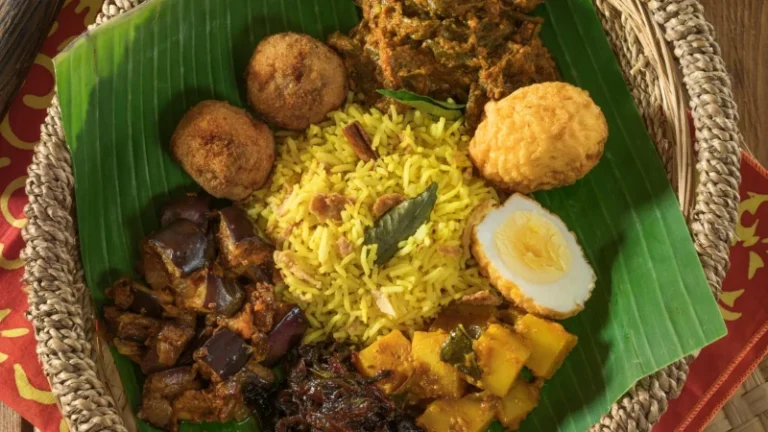Sri Lankan Lamprais — A Colonial Legacy Wrapped in Flavor
Sri Lankan Lamprais is not just a dish — it’s a cultural time capsule. This iconic Sri Lankan rice parcel, wrapped in banana leaves and filled with spiced meat, eggplant curry, sambol, and boiled egg, carries the influence of Dutch colonizers, Burgher community traditions, and generations of Sri Lankan home cooks.

The Colonial Origins of Lamprais
The word lamprais is believed to come from the Dutch word lomprijst, which loosely translates to “a packet of food.” It was brought to Sri Lanka by the Dutch Burghers, a Eurasian ethnic group descended from Dutch colonial settlers who blended local and European culinary traditions.
Originally served at festive family gatherings and Sunday lunches, lamprais combined the Dutch love of oven-baked meals with Sri Lankan spices and ingredients. Over time, it became a beloved specialty — especially in Colombo and Galle.
What Makes Lamprais Special?
- The rice is subtly spiced, cooked in stock or with aromatics like pandan and cloves.
- The meat curry (chicken, beef, or pork) is thick, dark, and deeply spiced — unlike runnier curries.
- The eggplant curry and sambol add sweetness, tang, and heat.
- Everything is wrapped in banana leaf and baked or steamed, infusing the meal with a rich, earthy aroma.
A Feast in a Leaf
Traditionally, lamprais was a complete meal wrapped into one parcel, easy to transport and perfect for sharing. Today, it’s still served in many homes and restaurants, especially on weekends or holidays.
You’ll often find it accompanied by Dutch-style frikkadels (fried meatballs), although modern versions simplify the recipe with just curry, eggplant, and sambol.
Why You Should Make Lamprais at Home
- It’s ideal for meal prep – one batch, many reheatable parcels
- It’s an impressive dish for guests – full of flavor and beautifully presented
- It’s customizable – vegetarian versions are just as satisfying
- It’s a journey through Sri Lankan culinary history in a single bite
Serving Suggestions
- Serve with a side of coconut chutney or raita to cool the palate
- Pair with iced tea, ginger beer, or a dry white wine
- Enjoy as a special Sunday lunch or wrap as a gift meal for a friend
Share this recipe
Sri Lankan lamprais

NUTRITION
Ingredients
For the rice
- 300 g white rice
- 1 pandan leaf
- 1 cinnamon stick
- 3 cloves garlic
- salt to taste
- 1 tbsp coconut oil
For the mixed meat curry
- 300 g chicken or beef in chuncks
- 1 onion chopped
- 2 cloves garlic minced
- 1 tsp ginger grated
- 1 tsp curry powder
- 1/2 tsp turmeric
- 1/2 tsp chili powder
- 1/2 tsp garam masala
- 100 ml coconut milk
- salt and pepper to taste
- 1 tbsp coconut oil
Sides (optional)
- 200 g eggplant curry
- 100 g lunu miris or seeni sambol
- 2 hardboiled eggs halved
- banana leaves lightly toasted
Instructions
- Cook the rice with pandan leaf, cloves, cinnamon, salt, and coconut oil. Set aside.
- Prepare the curry: Sauté onion, garlic, and ginger. Add chicken, spices, and coconut milk. Simmer until tender and thick.
- Prepare the sides: Fry or roast eggplant with turmeric and salt. Make lunu miris or use sweet caramelized onion sambol. Boil the eggs.
- Assemble parcels: Lay out a square of banana leaf. Add a scoop of rice, curry, eggplant, sambol, and a half egg.
- Fold into a neat parcel and steam or bake at 180°C for 15–20 minutes.
- Serve hot, in the leaf, for full aromatic impact.

